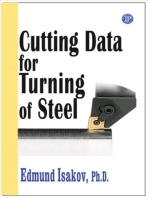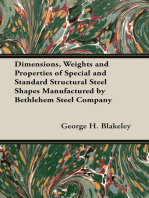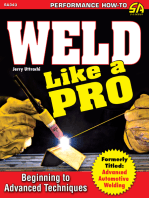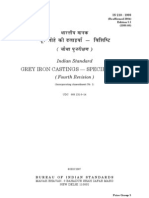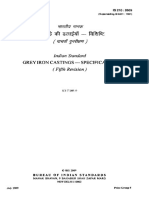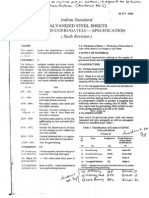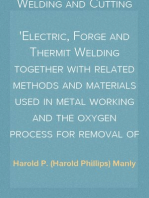Is 210
Is 210
Uploaded by
Debopriyo GhoshCopyright:
Available Formats
Is 210
Is 210
Uploaded by
Debopriyo GhoshOriginal Title
Copyright
Available Formats
Share this document
Did you find this document useful?
Is this content inappropriate?
Copyright:
Available Formats
Is 210
Is 210
Uploaded by
Debopriyo GhoshCopyright:
Available Formats
Disclosure to Promote the Right To Information
Whereas the Parliament of India has set out to provide a practical regime of right to
information for citizens to secure access to information under the control of public authorities,
in order to promote transparency and accountability in the working of every public authority,
and whereas the attached publication of the Bureau of Indian Standards is of particular interest
to the public, particularly disadvantaged communities and those engaged in the pursuit of
education and knowledge, the attached public safety standard is made available to promote the
timely dissemination of this information in an accurate manner to the public.
!"#$%&# '(%)
!"# $ %& #' (")* &" +#,-.
Satyanarayan Gangaram Pitroda
Invent a New India Using Knowledge
/0)"1 &2 324 #' 5 *)6
Jawaharlal Nehru
Step Out From the Old to the New
7"#1 &" 8+9&"), 7:1 &" 8+9&")
Mazdoor Kisan Shakti Sangathan
The Right to Information, The Right to Live
!"# %& ;<" =7"#" > 72 &(: ?0)"@" #AB 7" <&*" A*
Bhart+hariN,ti-atakam
Knowledge is such a treasure which cannot be stolen
IS 210 (2009): Grey Iron Castings [MTD 6: Pig iron and Cast
Iron]
July 2009
IS 210: 2009
(Superseding IS 6331 : 1987)
~ ~ ~ t c r t l ~ l I l - ~
( Wi/eif g;:r#erur )
Indian Standard
GREYIRON CASTINGS - SPECIFICATION
( F((th Revision)
res 7;.080!0
O BIS 2009
BUREAU OF INDIAN STANDARDS
MANAK BHAVAN. 9 BAHADUR SHAH ZAFAR MARG
NEW DELHI 110002
Price Group 5
Pig Iron and Cut Iron Sectional Conunittee, MTD 6
FOREWORD
This Indian Standard (Fifth Revision) was adopted by the Bureau of Indian Standards, after the draft finalized
by the Pig Iron and Cast Iron Sectional Committee had been approved by the Metallurgical Engineering
DivisionCouncil.
This standard was first pubIished in 1950 and subsequently revised in 1962, 1970, 1978 and 1993. The Pig Iron
and Cast Iron Sectional Committee decided to revise IS 210 by merging it with IS 6331 : 1987. After publication
of this standard, IS 6331 : 1987 will be withdrawn.
The various diameters of test bars according to the section size of the castings have been replaced by a
single size of test bar. Guidelines on the effect of section size of the casting on the tensile strength are,
however, given in Annex A. Acomparison between grades is given in Annex B.
The production of castings in the higher grades of grey cast iron often involves special techniques. It is
recommended, therefore, that for either large or intricate castings or a casting involving both these conditions,
or where the castings have to withstand exceptional conditions, the grade of grey cast iron selected and any
heat treatment involved should be agreed between the manufacturer and the purchaser. The higher grades of
grey cast iron (that is, Grades FG 300, FG 350 and FG400) present special difficulties for section 10 mmand
thinner.
For the benefit of the purchaser, typical properties of grey cast iron have been added in Annex C.
Information to be supplied by the purchaser while ordering grey iron castings according to this specification
is given in Annex D.
In the formulation of this standard assistance has been derived from ISO 185 : 2005 'Grey cast irons -
Classification', issued by the International Organization for Standardization.
For the purpose of deciding whether a particular requirement ofthis standard is complied with, the final value,
observed or calculated, expressing the result of a test or analysis, shall be rounded off in accordance with
IS 2: 1960 'Rules for rounding off numerical values (revised)'. The number of significant places retained in
the rounded off value should be the same as that of the specified value in this standard.
IS 210: 2009
Indian Standard
GREYIRON CASTINGS - SPECIFICATION
( Fifth Revision)
1 SCOPE
Thi s stand ard covers the requirements for grey iron
castings.
2 REFERENCES
namel y, grades FG 150, FG 200 , FG 220, FG 260,
FG 300, FG350 and FG 400 . The designat ion system
for grey cast iron is given in IS 4843 .
5 MANUFACTURE
3 SUPPLY OF MATERIAL
4 GRADES
There shall be seven grades of grey iron castings
General requirements relating to the supply of grey
iron castings shall be as laid down in IS 1387.
The castings shall be made by any process , as agreed
between the supplier and the purchaser , that will
produce castings complying with the requirement s
of this standard and shall be in accordance with the
pattern or working drawing as supplied by the
purchaser.
7 WORKMANSHIP AND FINISH
Where so required, the microstructure of grey iron
castings and the location for taking the sample shall
be as agreed to between the purchaser and the
manufacturer.
9.1 Unless otherwise specified, the microstructure
shall be substant ially free of primary cementite and/
or massive stead ite and shall consist oftlake graphite
in a matrix offerrite or pearlite or mixture thereof.
6 CHEMICAL COMPOSITION
6,1 The composition of cast iron shall be left to the
discretion of the manufacturer, but a maximum limit
for phosphorus and/or sulphur may be specified by
the purchaser, if he so desires.
6.2 In case ofspecial castings, the detailed chemical
composition shall be as agreed to between the
purchaser and the manufacturer.
9 MICROSTRUCTURE
7.1 The castings shall be accurately moulded in
accordance with the pattern or working drawings
supplied by the purchaser, with the addition of such
letters, figures or marks as may be specified.
7.2 The purchaser shall specify tolerances,
machining location and allowances with reference to
all important dimensions. On other dimensions
tolerances specified in IS 5519 shall apply.
Castings are generally supplied without having any
heat treatment. However , ifrequired by the purchaser,
the heat treatment may be carried out in accordance
with 20ftS 13655.
8 HEAT TREATMENT
Title
General requirements for the
supply of metallurgical material
(second revision)
Method for Brinell hardness test
for metallic materials (third
revision)
Metallic materiais - Tensile
testing at ambient temperature
(third revision)
Code for .designation of ferrous
castings
Recommended procedure for
repair of grey iron castings by
oxyacetylene and manual metal
arc welding
Deviations for untoleranced
dimensions of grey iron castin gs
(first revision)
Method for designat ion of
microstructure of graphite in cast
iron
Guidelines for heat treatment of
cas t iron
IS No.
1387: 1993
1500 : 2005/
ISO6506-1 : 1999
1608 : 2005/
ISO6892 : 1998 .
The follow ing standards contain provisions which,
through reference in this text, constitute provi sions
of this standard. At the time of publi cation, the
editions indicated were valid. All standards are
subject to revision and parties to agreements based
on this standard are encouraged to investigate the
possibility of applying the most recent editions of
the standards indicated below:
4843 : 1968
13655 : 1993
5139: 1969
5519 : 1979
7754 : 1975
IS 210: 2009
9.1.1 Unless otherwise specified. the graphite structure
shall be primarily Di stribution A in accordance with
IS7754.
10 FREEDOM FROM DEFECTS
10.1 The castings shall be sound, clean and free
from porosity. blow holes, hard spots. cracks. hot
tears. coldshuts, distortion, sand and slag inclusions
and other harmful defect s . They shall be well-
dressed and fettled, and shall be readil y machinable.
10.2 No welding or repairs shall be carried out
without the prior permission of the purchaser.
Welding referred to here includes fusion welding in
accordance with the common foundry practice. The
method of repair by welding (see IS 513Y) and
subsequent stress-relieving shall be as agreed to
between the purchaser and the manufacturer.
are poured. Moulds for the te st bars shall be
approximat el y at room temperature when poured.
More than one test bar may be ca st in a single mould.
but each bar in the mould sha ll be s urrounded by a
thickness of sa nd which is not less than the diameter
of the bar.
12 FREQUENCY OF TESTING
12.1 The number of test s requ ired for eac h melt or
batch of castings shall be as laid down in Table I,
various cl as ses of castings being divided into five
representative groups according to mass.
12.2 In the case of large tonnage of castings being
produced continuously. the min imum number of test
bars to be provided s ha ll be one ten sile test
representing every two hours of production from
melting furnace.
II PROVISION OF TEST BARS
13 SIZE OF TEST BARS
11.1 All test bars shall be cast separately in sand
moulds and the number of test bars required shall be
as specified in 11.2. They shall be cast at the same
time and from the same melt as the castings the y
represent.
A te st bar from wh ich the tensile test piece is
machined shall be cast as a uniform cylindrical bar of
30 mm diameter. The tolerance on the diameter shall
be +5mm. The minimum length of the test bar shall
be230mm.
11.2 The test bar material shall be identifiable with
that of the castings represented.
11.3 When castings are subjected to heat treatment ,
the test bars shall be heat-treated together with the
cast ings they represent .
11.4 The test bars shall be cast in dried, baked or
chemically bonded moulds made mainly of an
aggregate ofsiliceous sand with appropriate binders.
The average grain size of the sand shall be
approximate to that of the sand in which the castings
14 TENSIL.E TEST
The tensile test shall be carried out in accordance
with IS 1608. using a test piece conforming to the
dimens ions in Fig. 1 read with Table 2. The test piece
shall be accurately machined, with a good surface
fin ish . The transition between the ends and the
parallel length shall be smooth, without undercutting
or a sudden step down in diameter.
NOTE - Self-aligning grips are recommended to ensure
axial loading.
Table I NumberorTests
(Clause 12.\ )
Group
(II
:\1:155 of Individ1 Ca stings
(2)
Test Rftluinmtnts
(3)
Over I tonne
Up to 12.5 kg
Over 12.5 kg and up 10 50 kg
Over 50 kg and up to 500 kg
Over 500 kg and up to I tonne
I "
5
-t ' ,
3"
One test for each of 5 kg of castings or part thereof
One test for every I tonne of castings or part thereof
One lest for every 2 tonnes of castings or part thereof
One test for every 3 tonnes of castings or part thereof
One test for every 4 tonnes of cast ings or part thereof
or one test for every casting weighing 4 tonnes or more
t In addition Groups 1.2. 3 and -t all cast ings represented by one test shall be poured from the same ladle or same heat as the bar or
bars provide lor the test .
15 210 : 2009
FIG. I M ACHINED T ENSIl.E TEST PI ECE
Tabl e 2 Dimen sions of Machined Tensile Test Piece
(Clause 14)
All dimensions in rni llimctre s.
Ga uge Machining Minimum '\i nimum Pl ain Ends Sc r ewed Ends
l>ia meter -Tnle r a nce Parallel Radius A .A
' Milllmum n m u n ~ ' Minimum
"
D for the I.ength Minimum
Ga uge Diameter I.engt h Dia at Length
l>ia meter Root
L R d, L d, L
"
( I ) (2) (3) (4) ( 5) (6 ) (7) (8 )
20 0.5 55 25 23 6 5 25 30
NOTE - With screwed- ends. any form of thread may be used provided that the diameter at the root of the thread is not less
than that specified.
15 TENSILE STRENGTH
When tested in accordance with the requirements
of 14 the test piece shall comply with the minimum
requirements specified in Table 3 . The tensile
strength specified is that obtained from test bars cast
separately from the castings to wh ich they refer. The
test values represent, therefore, only the quality of
the metal from which the cast ings have been poured.
16 HARDNESS TEST
16.1 The Br inell hardness test shall be carried out in
Table 3 Mechanical Test Requirements
(Clauses 15and 16.1)
Grade Tensile Strrngth Brinrll
(su IS 4843) Min Hardness
Mra (N/OJ.') HBW
(I) (2) (J)
FG 150 150 IJO to 180
FG 200 200 160 to 220
FG 220 22 0 180 to no
FG 260 260 180 to 230
FG 300 300 180 to 230
FG 350 350 107 to 24 1
FG 400 400 207 to 270
NOTE - Although mechani cal prope rties are speci fi ed tor
Grade FG 150 the material shall be only tested if required by
the pur ch aser.
3
accordance with the method given in IS 1500 . Brineil
hardness values for different grades of grey iron
castings shall be as specified in Table 3.
16.1.1 The hardness tes t shall be cond ucted at
specific point on the cast ings. This specific po int
sha ll be such that they are ame ndable for hardness
checking to rout ine procedure and shall be as agreed
to bet ween the purchaser and the manu facturer.
17 TRANSVERSE TEST
Ifrequi red , the tr an sverse test may be ca rried out by
the manufacturer in accordance with the method
giv en in Annex E. The min imum test requi rements
shall be agreed upon at the time of enquiry and order.
18 HYDROSTATIC TEST
If speci fied at the time of enqui ry an d orde r the
ca stings ma y be te sted for the hydrost at ic test
pressure. Th e requirements for the test pressure shall
be mutu all y agree d to bet ween the purchase r an d
the manufacturer.
19 RETESTS
19.1 If on being tested any test piece shows obvious
sig ns o f a cas ting defect. the res ults of the test may
be discarded and a furthe r test be mad e.
19.2 lf any sound test pi ec e fails. two fur ther tests
sha ll be mad e. should either of these test piece s fail.
IS 210: 2009
the castings represented shall not comp ly with the
requirements of this standard.
19.3 In the absence of further separately cast test
bars, the manufacturer shall have the option of
submitting test bars, sect ioned from an agreed
pos ition in the castings. The requirements of the test
shall be as agreed to between the purchaser and the
manufacturer. However, the guidance may be
obtained from Annex A.
20 . INSPECTION
By agreement with the manufacturer, the purchaser
or his representative shall have access at all
reasonable times to those parts ofthe manufacturer 's
works engaged on his order, he shall be at liberty to
inspect the manufacturer at any stage, to witness
the required tests and to reject any material that does
not comply with this standard. When the castings
are to be inspected during manufacture and tested
in the presence of the purchaser's representative,
this shall be stated in the enquiry and order.
21 MARKING
21.1 Each casting, iffeasible, shall be legibl y marked
with a number of identification marks which it can be
traced to the melt , and the batch of heat treatment , if
done, from which it was made .
21.2 By agreement between the purchaser and the
manufacturer, castings compl ying with the
requirements of this standard sha l l be , after
inspect ion, legibly marked with an acceptance mark.
21.3 BIS Certification Marking
The castings may also be marked with the Standard
Mark.
21.3.1 The use of the Standard Mark is governed
by the provisions of the Bureau a/Indian Standards
Act, 1986 and the Rules and Regulations made
threrunder. The details of conditions under which
the licence for the use of Standard Mark may be
granted to manufacturers or producers may be
obtained from the Bureau of Indian Standards.
ANNEXA
(Foreword, and Clause 19.3)
APPROXIMATE VARIATIONOF STRENGTH
A-I The Indian Standard grades of grey cast iron
are based on the minimum tensile strength obtained
when metal is cast into test bars of 30 mm diameter.
The strength developed by a given metal shall vary
with the cooling rate in the mould higher strengths
being obtained ifthe same metal is cast into smaller
bars than 30 mm diameter and lower strengths if the
metal is cast into bars larger than 30 mm diameter.
Similarly, the cooling rate of a flat plate is slower
than that of a bar whose diameter is equal to the
thickness of the plate so that the strength developed
in the plate will be lower than that developed in the
bar.
A-1.1 The cooling rate ofa casting in a mould (hence
the strength developed in any particular section
thickness by the metal employed for its manufacture)
is influenced also by the presence of cores, changes
in sect ion thickness , the pressure of bosses
projection and intersection, such as the junctions of
ribs and bosses. Thus, in castings of other than
simple shape and uniform thickness the cooling rate
of any part can be expected to differ from that of a
4
flat plate of similar section thickness.
A-2 Figure 2 gives a guide to the likely variation in
tensile strength in different sections when a given
grade of grey iron is cast into a casting of simple
shape and uniform thickness or containing cored
holed where the cool ing rate in the mould of a given
section shall differ from that in a casting of sample
shape and uniform thickness, the diagram provides
only an approximate guide to the likely tensile
strength in different sections and design should be
based on the measured tensile strength in critical
parts of the casting.
A-2.1 Table 4 gives guidance to the likely variation
in tensile strength for different casting section
thicknesses when a given grade of grey cast iron is
cast into a casting of simple shape and uniform
thickness. For casting of non-uniform section or
castings containing cored holes, the table
only an approximate guide to the likely
strength in different sections, and casting
should be based on the measured tensile strength In
critical parts of the casting.
IS210 :2009
CROSS SECTIONAL THICKNESS,mm
350
5 15 25 50-75 100 125 150
l\l
350
E
E
-
300 z
300
II
ro
o,
250
..
250
:::x:
I-
(!)
z
200 w
-- 200
a:: --
I-
lI)
W --
150
--
.J
150
Vi
z
W
I-
100
100
0 15 30 50 75 100 125 150
BAR mm
FI<1. 2 VARIATION OF T ENSILE STRENGTH WITH CROSS-SECTIONAL T HICKNESSOF GREY IRON CASTINGS
Gradc
(I)
FG 150
FG200
FG260
FG300
FG350
Table 4 Anticipated Tensile Properties for the Castings
(For Infonnation Only)
(Clause A-2.l )
Casting Section Thidmrss Antieipaltd
mm Tensile Strengtb
Mr. (N/ mm
1
)
r
Up to and Over
(2) (3) (4)
2.5 10 155
10 20 130
20 30 11 5
30 50 105
2.5 10 205
10 20 180
20 30 160
30 50 145
4.0 10 260
10 20 235
20 30 215
30 50 195
10 20 270
20 30 245
30 50 225
10 20 315
20 30 290
30 50 270
5
IS 210: 2009
ANNEX B
(Forewords
COMPARISON BETWEENGRADES
MPa
GRADE
(.N/mm
2
)
h I<gf/mm
2 GRADE
FG I. 00
400
40
1.0
FG 350
350
35
35
FG 300
300
30
30
FG260
250
25
25
FG 220
FG200
200
20
20
FG1S0
150
15
15
MPa
(:N/mm
2
)
CONVERSION FACTOR 1 N/mm
2_
lMPa-01020 kg1.!mm
2
FIG. 3 COMPARISON B ETWEENG RADES IN T HIS EDITION AND THE PREVIOUS EDI TION
B ASED ON M INIMUM T ENSILE STRENGTH
ANNEXC
(Foreword)
TYPICAL PROPERTIES OF GREY CAST IRON
Tl,e following information is given for the guidance of engineers and designers. It does not form part of the
standard and should not be used for acceptance purposes:
~
FG300 FG350 FG400
300
350 400
M
98
1I2
195 228
1f:J)
0.50 0.50
0.50
0.22 025
018
028 025
018
176 208
240280
160
169
020
FG260
260
73
120
143
0.18
FG220
220
62
130
0.17
FG200
200
56
0.45-0.60
11
0.31-0.50
1
) 0.21-0.45
1
) OJ7
0.15
0.60-0.75
1
) 0.48-0.67
1
) 0.39-0.63
1
) 0.57
Grades
_--------.-A-------------
r
FGI50
150
42
Percent
Percent
MPa(N/mm
2
) 98
M P a N m m ~
MPa(N/mm
2
)
Notched tensile strength
320 (see Note2)
(Circumferential
45 V-notch, root
Properties Unit
Tensile strength
0.0I percent proof
stress
0.1 percent proof
stress
Total strain at
failure
Elastic strain at
failure
Total minus Percent
elastic strain at failure
6
IS 210 : 2009
Properties Unit Grades
~
r- ~
FGl50 FG200 FG220 FG260 FG300 FG350 FG400
radius0.25nun or
notchdepth 2.5 mm,
notchdia 20 mmor
notch depth 3.3 nun,
notch diameter
7.6mm)
Circumferential MPa(N/nun
2
) 150 200 220 260 300 350 400
notch, radius9.5 mm
(notch depth2.5 rom,
notch diameter 20rom)
Compressive MPa(N/mm
2
) 600 120 768 864 960 1080 1200
strength
0.0I percent proof MPa(N/nun
2
) 84 112 128 146 168 196 224
stress
0.1 percent proof MPa(N/nun2) 195 260 286 338 390 455 520
stress
Shear strength MPa(N/nun2) 173 230 253 m 345 403 460
Torsional strength MPa(N/nun2) 173 230 253 m 345 403 460
Shearstrainat failure Percent >4 >4 >4 >4 Upt04 Upto4 Upt04
Modulusof elasticity:
Tension GPa 100 114 120 128 135 140 145
Compression GPa 100 \14 120 128 135 140 145
Modulus of GPa 40 46 48 51 54 56 58
rigidity
Poisson's ratio
(
026
)
Fatiguelimit(Wohler):
Unnotched (8.4nun) MPa(N/rnrnl) 68 90 99 117 135 149 152
dia
V-notched MPa(N/mm2) 68 87 9t ~ 122 129 127
(Circumferential45
V-notch with025 nun
root radius,
Diameter at notch
8.4nundepthof
notch3.4 mm)
Coefficientof
thermalexpression:
-IOO'Cto2O"C
X ~
(
10.0(see Note3)
)
2O"Cto200'C X ~
(
11 .0 (see Note3)
)
2O"Cto4OO'C X ~
(
12.5(see Note3)
)
Thermal
conductivity:
100'C W/(mk) 525 50.8 50.1 48.8 47.4 45.7 44.0
200'C W/(mk) 51.5 49.8 49.1 47.8 46.4 44.7 43.0
300'C W/(mk) 505 48.8 48.1 46.8 45.4 43.7 420
4OO'C W/(mk) 495 47.8 47.1 45.8 44.4 427 41.0
5OO'C W/(mk) 485 46.8 46.1 44.8 43.4 41.7 40.0
7
IS 210: 2009
Properties
Unit
Grades
.-/'-.
,r
--....,
FG 150
FG200 FG220 FG260 FG300 FG350 FG
Specificheal
capacity:
2O"C to200"C
Jl1cgK 265 375 420 460 460 460 460
2O"C to300"C
Jl1cgK 355 435 455 495 495 495 495
2O"C to400"C Jl1cgK 400 465 465 505 505 505 505
2O"Cto500"C Jl1cgK 425 480 475 515
515 515 515
2O"C to6OO"C Jl1cgK
445 500
495 535 535 535 535
2O"C 1070O"C Jl1cgK 490 555 560 605 605 605 605
Relative density: (kg/dm') 7.05 7.10 7.15 720 725 730 730
Magnetic and
electrical properties
Maximum magnetic IJH/m
( 301 to 380
,
/
permeability
Remnant magnetismT
( 0.4 to 0.5
)
Coerciveforce Aim
(
560 to 720
)
Hysteresis loss J/m
2 (
2 500to 3000
)
8150Hz Wlkg
( 17.6to 20.9
)
Electrical resistivity IJ!lIm 0.800 o.no 0.760 0.730 0.700 0.670 0.640
NOTES
I The typical propert ies given in this Annex are the propert ies in 30 mm diamet er separ ately cast test bar or in a
cast ing section correctly represented by this size of test bar where the tensile strength does not correspond to that
ginn, other propert ies may differ slightly from those given.
2 Notched tensile strengths increase slightly as notch severity ratio. notch radius, notch diameter, increase above 0.47.
J The values quoted for coefficient of thermal expansion of grade FG 400 are for mater ial in pearlitic iron, where
accieular iron is used for this grade appropriate values are:
2O'Cto 200'C 15.0 )( Io-<'IK
2O'Cto 4OO'C 16.5 )( Io-<'IK
I> Values depend on the composition of iron.
ANNEXD
(Foreword)
INFORMATIONTO BESUPPLIED BY THE PURCHASER
0-1 BASIS FOR ORDER
While placing an order for the purchase ofgrey iron
casting covered by this standard, the purchaser
should specify the following:
a) Material specification;
b) Any required limits on the sulphur and
phosphorus content;
c) Drawing or reference number of the pattern (if
supplied by the purchaser) along with a copy
of the drawing;
8
d) Test required;
e) Whether the castings are to be inspected and
tested in the presence of the purchaser's
representative;
f) Condit ion of delivery ;
g) Any special requirement of the purchaser, foi
example, hardness tests and locations of non-
destruct ive testing, quality assurance, etc; and
h) Test reports, if required.
IS 210: 2009
I' _ 8PL
s
Jb - --3-
1td
o
where
P maximumload at fracture inN,
L. distance between centres ofsupports
inrnrn.and
d. = mean diameter in nun, and
c) deflection at fracture in rom.
E-3.2 Increase the load uniformly without shock until
the bar fracture. The load should be applied in such
a way that the increase of stress does not exceed
3 MPa/s. Find out the load at the fracture of the test
bar with the accuracy indicated in Table 6.
E-3.3 Determine the deflection of the test bar fromthe
motion of the thrust relative to the fixed supports or to
the supporting table ofthe machine. Inorderto eliminate
any errors in measuring the deflection, themeasurement
should be stated after applying a small preload as given
in Table 6.
E-4TESTRESULT
The test report shall include:
a) load at fracture in N;
b) bending to an accuracy of 0.5 MPa
calculated fromthe formula:
ANNEXE
(Clause 17)
TRANSVERSE TEST FORGREYCAST IRON
E-l OBJECfOFTHETEST
The object of this test is to determine the transverse
bending strength of grey cast iron by applying
constantly increasing single load at the centre of a
test bar arranged as a beam between two supports
until fracture occurs.
E-2 TEST BARS
E-2.1 The cast test bar shall have the dimensions
given in Table 5.
E-2.2 Test bar is normally tested unmachined. The
surface of the test bar shall be free from unevenness
and seams which may be removed by careful
grinding. The diameter shall be measured at the
centre of the test bar in two directions perpendicular
to one-another. The difference between two
measurements shall not exceed 5 percent of the
normal diameter. The mean value ofthe two diameters
shall be the diameter do (see [-4) ofthe test bar. For
its permissible variations from the nominal diameter
and the accuracy of measurement of the diameter,
the values indicated in Tables 5 and 6 shall apply.
E-3PROCEDURE
E-3.1 Place thl': two ends of the test bar on horizontal
supports. The support and the point of application of
the load shall be rounded to a radius of 5 to 20 rom.
Apply a single load vertically at the centre of the bar
(seeFig. 4).
Table S Dimensions of Traasvene Test Ban
(Clauses E-2.1 and E-2.2)
All dimensions in millrmetres.
(4)
Luet" (L)
MI"
Mlchined'\
(3)
Permlssiblc Vsristlo. fro.
No.i.al Dis.erer
_------A-------.
Diamder of tbe
Cast Tu. Bar
(I)
30
1.2 O.2 SOO
Table 6 Testing Conditions and Accuracy of Readings
(Clauses E-2.2, E-3.2 and E-3.3)
Nomi ..1
Dis ..der
d
mm
(I)
30
Diitsacc
Betweu
Ceatre of
Supports
L.
mm
(2)
450
A1Irlcy of Rradhap
P-
rDiameter of Load P, Dctlectioil\
Bar Max at Fracture
d
mm N mm
(3) (4) (S)
0.1 100 0.2
N
(6)
200 to400
9
IS 210: 2009
LOAD POSITION
i
L
Ls
~
-I -_.
AR OF GREY CAST IRON
4 TRANSVERSE TEST B FIG.
L
1:::-$-
512009-24 72lXJ9..--.,:jQ( Books
MGIPF-112Deptt ofBl
10
Bureau of !nd tan Standards
SIS i" ;1' : :,:I1(;'v instit ution established under the Bureau otlndi.in Standard, Ac(, IQ86 to promote harmonious
"t' the acti viue- o f standardization. marking and quality certification of goods and attending 10
connect ed matters in the country.
Copyr ight
B1 S has the copyright of all its publications. No part of these publications may be reproduced in any formwithout
the prior permission in writ ing ofB IS. This does not preclude the tree use, in course of implementing the standard,
of necessary details, such as symbols and sizes, type or grade designations. Enquiries relating to copyright be
addressed to the Director (Publications), BIS.
Review of Indian Standards
Amendments are issued to standards as the need arises on the basis of comments. Standards are also reviewed
periodically; a standard along with amendments is reaffirmed when such review indicates that no changes are
needed; if the review indicates that changes are needed, it is taken up for revision. Users of Indian Standards
should ascertain that they are in possession of the latest amendments or edition by referring to the latest issue of
'BIS Catalogue' and ' Standards: Monthly Additions' .
This IndianStandard has been developed fromDoc No. : MTD6 (4830\
Amendments Issued Since Publication
Amendment No. Date of Issue Text Affected
- --- - - ---_._- _ ._- - - - - - - - - - -
BUREAUOFINDIANSTANDARD:;
Headquarters:
ManakBhavan,9 Bahadur Shah lafar Marg, NewDelhi 110002
Telephones:23230131.23233375. 2323<)402 Website: www bis.org.ir.
Telephones
{
. 2323 7617
2323384i '
f 23378499,23378561
l 23378626,23379120
{
2603843
2609285
f 22541216,22541442
l
{
28329295,28327858
2832 7891,28327892
Branches: AHMEDABAD. BANGALORE. BHOPAL. AHUF3 i\ NESHWAR. COIMBATORE. FARIDABAD.
GHAlIABAD. GUWAHATI. HYDERAAAD J/ . I PUR. KANPUR. LUCKNOW. NAGPUR.
PARWANOO. PATNA. PUNE. RAJKOT. THIF l i\.r\ '\ '\THAPURAM. VISAKHAPATNAM .
Regional Offices:
Central : M3:1ak Bhavan, 9 Bahadur Shah Zafar Marg
Eastern : 1/14, CI.T. Scheme VII M. v.I.P. Road, Kankurgach.
KOLKATA 700054
Northern : SC0335-3 36,Sector 34-A CHANDIGARH 160022
Southern : CI.T. Campus, IVCross Road, CHENNAI 60011 3
22542519, 22542315
Western : Manakalaya. E9 MIDC, Marol, Andheri (East)
MUMBAI 400093
You might also like
- IS 1079 Hot Rolled Carbon Steel SheetsDocument12 pagesIS 1079 Hot Rolled Carbon Steel Sheetssdmel75% (8)
- Asme Section II A Sa-278Document6 pagesAsme Section II A Sa-278Anonymous GhPzn1xNo ratings yet
- 1977Document11 pages1977Vineet Krishan67% (3)
- Dimensions, Weights and Properties of Special and Standard Structural Steel Shapes Manufactured by Bethlehem Steel CompanyFrom EverandDimensions, Weights and Properties of Special and Standard Structural Steel Shapes Manufactured by Bethlehem Steel CompanyNo ratings yet
- Weld Like a Pro: Beginning to Advanced TechniquesFrom EverandWeld Like a Pro: Beginning to Advanced TechniquesRating: 4.5 out of 5 stars4.5/5 (6)
- All-in-One Manual of Industrial Piping Practice and MaintenanceFrom EverandAll-in-One Manual of Industrial Piping Practice and MaintenanceRating: 5 out of 5 stars5/5 (1)
- Is-210 - Grey Iron CastingDocument12 pagesIs-210 - Grey Iron CastingManoj SethiNo ratings yet
- Is 210 PDFDocument12 pagesIs 210 PDFmaheshkbandari100% (4)
- Is 1865 1991Document16 pagesIs 1865 1991kumarkk1969No ratings yet
- 1865Document13 pages1865rskcadNo ratings yet
- Disclosure To Promote The Right To Information: IS 14329 (1995) : Malleable Iron Castings (MTD 6: Pig Iron and Cast Iron)Document13 pagesDisclosure To Promote The Right To Information: IS 14329 (1995) : Malleable Iron Castings (MTD 6: Pig Iron and Cast Iron)anand.bharadwaj50% (2)
- 210Document12 pages210kumarkk1969No ratings yet
- Grey Iron Castings Specification: Indian StandardDocument12 pagesGrey Iron Castings Specification: Indian StandardS Karthi100% (3)
- Is 3930Document19 pagesIs 3930IPSITNo ratings yet
- Is 3502 2009 PDFDocument10 pagesIs 3502 2009 PDFRajashekar.PNo ratings yet
- Is 210 PDFDocument13 pagesIs 210 PDFJagdeep DhillonNo ratings yet
- Indian Standard 276Document9 pagesIndian Standard 276sdmelNo ratings yet
- Indian Standard - 2644Document8 pagesIndian Standard - 2644Biswajit DasNo ratings yet
- I S 210 - 1993 PDFDocument12 pagesI S 210 - 1993 PDFMuthusamy Arumugam100% (2)
- 1079Document12 pages1079Akhileshkumar PandeyNo ratings yet
- Cartridge Brass Sheet, Strip, Plate, Bar, and Disks (Blanks)Document5 pagesCartridge Brass Sheet, Strip, Plate, Bar, and Disks (Blanks)LUISALBERTO06011985No ratings yet
- Cf'Mm6Bl-Ir (Wtaqd ) - M-I-F&Document15 pagesCf'Mm6Bl-Ir (Wtaqd ) - M-I-F&Ankush JainNo ratings yet
- Is 10343 1999Document11 pagesIs 10343 1999Arjuna ReddyNo ratings yet
- Asme Section II A-2 Sa-476 Sa-476mDocument6 pagesAsme Section II A-2 Sa-476 Sa-476mAnonymous GhPzn1xNo ratings yet
- Is 277 - 2003Document8 pagesIs 277 - 2003chandrani_acsNo ratings yet
- Is 5986-2011Document14 pagesIs 5986-2011oneakshay100% (1)
- Is 1079 2009Document9 pagesIs 1079 2009renjisrsNo ratings yet
- UNI 11037 - Steel Fibers For ConcreteDocument9 pagesUNI 11037 - Steel Fibers For ConcreteJoaquín Indacochea BeltránNo ratings yet
- Disclosure To Promote The Right To InformationDocument11 pagesDisclosure To Promote The Right To InformationRishith Ellath Meethal VadakaraNo ratings yet
- Is 9417 1989Document15 pagesIs 9417 1989Ganesh RajaNo ratings yet
- Is 5522 1992Document6 pagesIs 5522 1992psewagNo ratings yet
- Is 2856 1999 Carbon Steel Castings For Pressure Containing Parts Suitable For Fusion WeldingDocument11 pagesIs 2856 1999 Carbon Steel Castings For Pressure Containing Parts Suitable For Fusion WeldingpsewagNo ratings yet
- Is 1079 (2009) - Hot Rolled Carbon Steel Sheet and StripDocument13 pagesIs 1079 (2009) - Hot Rolled Carbon Steel Sheet and StripJeetu GosaiNo ratings yet
- Draft - Is - Code PDFDocument12 pagesDraft - Is - Code PDFdbhawal6388No ratings yet
- Disclosure To Promote The Right To InformationDocument11 pagesDisclosure To Promote The Right To InformationSantosh KumarNo ratings yet
- Lowcarbongalvanizedsteelwires, Formedwiresandtapesfor Armouringofcables - SpecificationDocument8 pagesLowcarbongalvanizedsteelwires, Formedwiresandtapesfor Armouringofcables - SpecificationShrikant KajaleNo ratings yet
- Is 2004Document7 pagesIs 2004raghav248No ratings yet
- Is 2707Document6 pagesIs 2707RSP1234No ratings yet
- ASTM A842 - Corpo de Prova OmegaDocument4 pagesASTM A842 - Corpo de Prova OmegaFabiano MonteiroNo ratings yet
- Is 2004Document7 pagesIs 2004shanrama100% (1)
- Disclosure To Promote The Right To InformationDocument18 pagesDisclosure To Promote The Right To InformationSantosh KumarNo ratings yet
- Steel Is.6603.2001 PDFDocument20 pagesSteel Is.6603.2001 PDFhiren_mistry55No ratings yet
- Is 2830 1992Document9 pagesIs 2830 1992Sunny SaparNo ratings yet
- Is 2644Document11 pagesIs 2644IPSITNo ratings yet
- Mildsteeltubes, Tubctlars Andother Wroughtsteel Fittings-SpecificationDocument17 pagesMildsteeltubes, Tubctlars Andother Wroughtsteel Fittings-SpecificationRakesh SrivastavaNo ratings yet
- Is - 1030Document8 pagesIs - 1030Aaditya SharmaNo ratings yet
- Spot Welding Interview Success: An Introduction to Spot WeldingFrom EverandSpot Welding Interview Success: An Introduction to Spot WeldingNo ratings yet
- Boiler Making for Boiler Makers - A Practical Treatise on Work in the ShopFrom EverandBoiler Making for Boiler Makers - A Practical Treatise on Work in the ShopRating: 4.5 out of 5 stars4.5/5 (2)
- Thixoforming: Semi-solid Metal ProcessingFrom EverandThixoforming: Semi-solid Metal ProcessingGerhard HirtNo ratings yet
- Ceramic Materials for Energy Applications VIFrom EverandCeramic Materials for Energy Applications VIHua-Tay LinNo ratings yet
- Handbook of PVC Pipe Design and Construction, 6th EditionFrom EverandHandbook of PVC Pipe Design and Construction, 6th EditionNo ratings yet
- Advances in Ceramic Armor XIFrom EverandAdvances in Ceramic Armor XIJerry C. LaSalviaNo ratings yet
- Oxy-Acetylene Welding and Cutting Electric, Forge and Thermit Welding together with related methods and materials used in metal working and the oxygen process for removal of carbonFrom EverandOxy-Acetylene Welding and Cutting Electric, Forge and Thermit Welding together with related methods and materials used in metal working and the oxygen process for removal of carbonNo ratings yet
- Advances in Solid Oxide Fuel Cells XFrom EverandAdvances in Solid Oxide Fuel Cells XMihails KusnezoffNo ratings yet
- Advanced Processing and Manufacturing Technologies for Nanostructured and Multifunctional Materials IIIFrom EverandAdvanced Processing and Manufacturing Technologies for Nanostructured and Multifunctional Materials IIITatsuki OhjiNo ratings yet
- How to prepare Welding Procedures for Oil & Gas PipelinesFrom EverandHow to prepare Welding Procedures for Oil & Gas PipelinesRating: 5 out of 5 stars5/5 (1)



